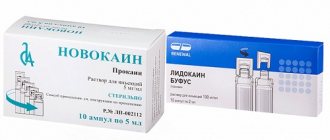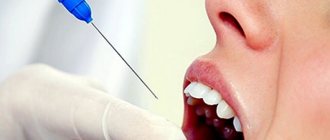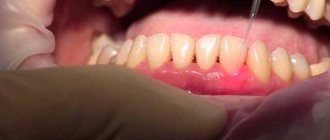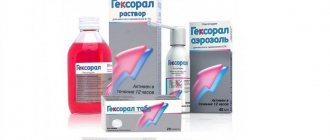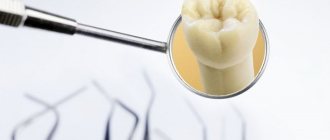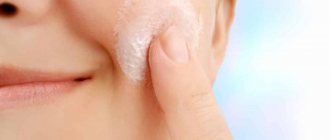Comparison of Lidocaine and Ultracaine
Local anesthetics help cope with severe pain in inflammatory diseases and injuries. Patients are wondering which pain reliever is better: Lidocaine or Ultracaine. The choice of drug is determined by many factors, including individual tolerance of the components.
Lidocaine or Ultracaine help cope with severe pain in inflammatory diseases and injuries.
Characteristics of Lidocaine
The anesthetic has the following characteristics:
- Dosage form and composition. The drug is available as an injection solution, which is a clear, odorless liquid. 1 ml of the product contains 20 or 40 mg of lidocaine and water for injection. The solution is packaged in ampoules of 2 ml, supplied in contour cells of 5 pcs.
- Pharmachologic effect. The drug is a pain reliever that has a short-term effect. The mechanism of action is based on reducing the permeability of neuron membranes. The result of the injection is a change in the threshold of pain sensitivity, causing numbness of the tissues. The use of Lidocaine helps normalize the heart rate.
- Pharmacokinetics. Lidocaine is quickly distributed throughout the tissues. The amount of substance entering the blood depends on the injection site. The maximum concentration of lidocaine in plasma is achieved with subcutaneous, epidural or intercostal administration. Approximately 60% of the administered dose interacts with blood proteins. In the liver, the active substance is converted into inactive metabolites, which are excreted in the urine.
- Scope of application. The drug is used to provide local and regional anesthesia for minor surgical interventions.
- Contraindications. Lidocaine is not used for high-degree atrioventricular block, a decrease in circulating blood volume, or individual intolerance to the components of the solution.
- Mode of application. The dose is selected depending on the injection site and tolerability of the substance. The drug is recommended to be used in minimal effective doses. If it is necessary to administer a large volume of a product with a low concentration of the active substance, the contents of the ampoule are diluted with saline solution. Doses for children are selected according to age and body weight.
- Side effects. The administration of Lidocaine may be accompanied by the following negative consequences:
- allergic reactions (anaphylactic shock, Quincke's edema);
- neurological disorders (sleep disturbance, numbness of the tongue, increased nervous excitability, coma, confusion, dysfunction of the respiratory center);
- signs of spinal cord damage (spontaneous discharge of urine and feces, cauda equina syndrome, paralysis of the lower extremities);
- decreased visual and hearing acuity;
- cardiovascular reactions (poor circulation, decreased heart rate, arterial hypotension, arrhythmia);
- respiratory disorders (bronchial asthma attacks, respiratory arrest, shortness of breath);
- nausea and vomiting;
- local reactions (swelling of soft tissues, itchy skin rashes).
The administration of Lidocaine may be accompanied by allergic reactions (anaphylactic shock, Quincke's edema).
Instructions for use in dentistry
The drug is indicated for use for infiltration and conduction anesthesia during operations and diagnostic interventions to relieve pain.
Ultracaine in dentistry is prescribed for a variety of procedures, including filling and extraction of teeth, during the installation of crowns, during preventive procedures, and treatment of wounds. Administration is also practiced during surgical interventions performed in the nasopharynx.
The instructions for Ultracaine stipulate that the drug is injected subcutaneously in 5-10 ml doses. But before using the product, the patient needs to undergo all the necessary diagnostic procedures. After the surgical intervention has been performed, the patient’s blood pressure is clearly monitored, as well as the state of his central nervous system and respiratory system.
Instructions for the use of Ultracaine in dentistry stipulate that when filling or removing teeth, 1.5 ml of the product is injected into the palatal suture. The highest dose for an adult should not be more than 7 mg; for children after the age of four, a dose of no more than 5 mg of the drug is indicated.
For infiltration anesthesia, Ultracaine is used in the following doses: for tonsillectomy, 5-10 ml of the drug is used for each tonsil; when reducing fractures, 5 to 20 ml of Ultracaine can be used; when applying a perineal suture - 5-15 ml.
During conduction anesthesia, depending on the type of intervention, from 1 to 30 ml of the drug can be administered.
Lidocaine belongs to the chemical properties of amides. It has a deep analgesic effect. When compared with other existing anesthetics, lidocaine has an average effect on toothache. But it is stronger than the commonly used novocaine. It is these named drugs that are always used in public dental clinics.
The history of the use of painkillers is divided into two periods: before the present day and after. Today, more effective drugs are used as painkillers than before. Medicines that were previously used as anesthesia are outdated and have lost their relevance.
We suggest you read: How does chlorhexidine differ from miramistin in composition?
Thanks to the injection, the pain signal entering the brain is blocked. The patient stops feeling pain and therefore begins to behave calmly. In turn, the doctor can carry out a number of surgical and therapeutic procedures through which the disease is cured. All procedures and manipulations in this case take place quickly, without complications, with high quality, correctly and in the required volume.
Some dental procedures were previously performed without anesthesia. Therefore, people were terribly afraid of the dentist's office, delaying the visit until the last stage. Today there is no such thing. The patient knows that in the hospital he will be given an anesthetic injection and the procedure will be almost painless. More and more people are visiting dentistry at the right time. Now a number of complications can be avoided.
Has a local anesthetic effect. Promotes vasodilation without tissue irritation. It is evenly distributed over the treated area for a short period of time.
- tooth extraction;
- gingivitis;
- painful teething;
- irritation of the mucous membrane due to dentures;
- stomatitis;
- removal of tartar;
- opening of cystic formations.
In dentistry, it is mainly used in ampoules. In other forms it can be used for toothache at home.
- allergy to lidocaine components,
- significant impairment of liver function,
- sick sinus syndrome,
- 2-3 degree atrioventricular block,
- severe bradycardia,
- myasthenia gravis, cardiogenic shock.
Ultracaine is recommended for use as an anesthetic in the treatment of the following dental problems:
- placing a filling on a tooth;
- deleting unit;
- prosthetics;
- preventive actions;
- when treating open wounds in the mouth;
- when removing an abscess.
Do not inject yourself!
The injection of Ultracaine is carried out by a doctor. Only a professional can inject correctly without damaging the vessel with the needle tip.
To avoid intra-articular puncture, it is recommended to perform a test before injection using special syringes (for example, Uniject K, Uniject® K).
Testing (aspiration) involves releasing a small amount of solution from a single dose to determine the correct direction for the injection and identify possible allergies. When releasing the solution, tissue sensitivity must be taken into account.
Ultracaine is injected into the oral cavity (into the mucous membrane, into the gum tissue located around the circumference of the causative tooth).
Rules for administering the solution for conduction/infiltration anesthesia and the norms of single doses:
- removal of a unit, regardless of the row, when there is no inflammatory process - 1.7 ml per tooth (the puncture is made in the transitional fold);
- tooth preparation – from 0.5 to 1.7 ml for each unit;
- trimming the palate, the need to apply surgical sutures - 0.1 ml;
- removal of premolars on the lower row in the absence of inflammation - 1.7 ml;
- for additional pain relief, when the first dose did not give the desired effect - 1.0 - 1.7 ml into the submucosa in the zone of the transitional fold (frontal side);
- simple tooth filling – 1 ml;
- a complex process with filling and removal of a unit - up to 1.7 ml.
The maximum permissible daily amount of Ultracaine for local anesthesia:
- adult patients – 7 ml;
- children's group – 5 ml.
When performing medical procedures to eliminate various dental problems, in particular the removal of teeth in children, Ultracain is often used. Age threshold – 4 years.
The initial use of the anesthetic involves preliminary testing for an allergic reaction. If the child shows signs of intolerance to the active substance, the doctor selects another type of pain reliever.
There are no restrictions on the use of Ultracaine during pregnancy; a tiny amount of the active substance penetrates the hematoplacental membrane. There is no need to wean your baby from the breast during lactation. The drug will not cause any harm to the baby’s health; milk contains a tiny amount of the active substance. But using an anesthetic on a patient whose blood contains alcohol is strictly prohibited.
With the correct choice of anesthesia technique, an adequate level of pain relief can be obtained regardless of the type of anesthetic. The sensitivity of lidocaine to the action of tissue fluid can be compensated for by conduction anesthesia. In this case, it is possible to achieve an adequate level of pain relief and reduce the dose of anesthetic.
That is why most dentists prefer to use ultracain, which makes it possible to refuse the use of technically complex methods of conduction anesthesia, including on the lower jaw, while:
- the risk of local complications, such as nerve trunk injury or hematoma, is reduced due to the abandonment of conduction anesthesia;
- there are no side effects in the form of numbness of the lip, half of the jaw, or tongue, which allows patients to lead a normal life immediately after visiting the dentist;
- the time of medical appointment is reduced, since infiltration anesthesia with ultracaine occurs 3-5 minutes after administration, and not after 15-30, like conduction anesthesia with lidocaine.
Ultracaine is an ideal agent for performing superficial anesthesia in dentistry, but its use for conduction anesthesia in outpatient practice is not justified.
There are also negative reviews from patients about the use of ultracaine. Most often, negative sensations arise from the wrong choice of pain relief technique or as a result of the side effects of adrenaline.
- Ultracaine's unique ability to diffuse, combined with its resistance to tissue fluid, often turns conduction anesthesia into central one. In this case, half of the patient’s face may become numb (instead of the expected anesthesia of the lateral teeth of the upper or lower jaw) or begin to see double after anesthesia during the treatment of the frontal incisor. Since the effect of the anesthetic is completely reversible, this condition is not dangerous, but it is quite difficult to experience emotionally.
- When choosing an anesthetic, you need to take into account concomitant diseases and the general condition of the patient. It is imperative to inform your doctor about the presence of hypertension, pathology of the thyroid gland and cardiovascular system, as well as undesirable reactions to anesthetics with adrenaline, if they have already occurred before. In this case, you need to use Ultracain D, which does not contain adrenaline.
The usual use of Ultracain is in dentistry for depulping teeth, removing them and other manipulations. The anesthetic penetrates well into bone structures and anesthetizes inflamed tissue. Due to this, Ultracain D-S is preferred when performing operations on ENT organs (removing tonsils, correcting a deviated nasal septum, etc.).
Lidocaine is used much more widely. In addition to pain relief, it is an antiarrhythmic drug that is used in cardiology. In addition, the drug is administered intravenously to relieve acute surgical and chronic pain; used in general anesthesia in combination with propofol. Lidocaine is convenient for superficial anesthesia during gastroscopy and other endoscopic examination methods. And, of course, it is still used as a local anesthetic in otolaryngology and dentistry.
We suggest you read: Why teeth rot in young children
Despite the reduced toxicity, Ultracaine has contraindications. Absolute restrictions include:
- hypoxia;
- glaucoma;
- intolerance to anesthetic components;
- cardiac tachycardia;
- anemia (lack of vitamin B12).
Relative contraindications include heart problems, bronchial asthma, and diabetes. In these cases, the use of Ultracaine is possible, but it must be justified, and the anesthetic should be used only under the supervision of a specialist. This type of pain relief is permitted during breastfeeding and pregnancy.
Action of Ultracaine
The drug is available in the form of a clear solution for injection, 1 ml of which contains 40 mg of articaine and 12 mcg of epinephrine.
The anesthetic causes a temporary loss of sensitivity associated with a decrease in the speed of nerve impulses.
Articaine reduces the permeability of neuronal membranes to sodium ions. Epinephrine prolongs the effect of the local anesthetic. Articaine is quickly converted to an inactive metabolite, which explains the low risk of side effects. The negative effect of Ultracaine on the body is manifested by the following symptoms:
- neurological disorders (confusion, respiratory arrest, trembling of the limbs, temporary decrease in visual acuity, seizures, headache, dizziness, decreased sensitivity of the skin, damage to the facial nerve);
- digestive disorders (nausea, vomiting, slow intestinal motility, encopresis);
- dysfunction of the cardiovascular system (arterial hypotension, decreased heart rate, heart failure, cardiogenic shock);
- allergic manifestations (redness of the skin, inflammation of the conjunctiva and nasal mucous membranes, Quincke's edema, urticaria, attacks of bronchial asthma);
- local reactions (pain at the injection site, impaired blood supply to tissues, up to necrosis).
What is the difference and similarity between Lidocaine and Ultracaine?
The similarities between the drugs include the following characteristics:
- pharmacological group (both drugs belong to local anesthetics);
- effect on the human body (Lidocaine and Ultracaine reduce the speed of nerve impulses, causing tissue numbness);
- scope of application (drugs are used for local and infiltration anesthesia).
The differences between medicines are the following qualities:
- composition (Ultracaine is produced on the basis of articaine and epinephrine, Lidocaine contains the active substance of the same name);
- duration of effect (Ultracaine’s effect lasts longer);
- frequency of occurrence of negative consequences (when using Lidocaine, side effects occur more often).
What is better to take - Lidocaine or Ultracaine?
Ultracaine has a more powerful effect and a lower risk of side effects. When the dose is selected correctly, the drug has a pronounced analgesic effect and does not have a negative effect on the body.
Ultracaine has a more powerful effect and a lower risk of side effects.
Ultracaine or lidocaine, which is better for tooth extraction?
Swelling of the gums, not accompanied by toothache –
What causes dental caries in adults, reasons
What causes caries? This question concerns
After tooth extraction, the hole does not heal, what to do?
After visiting the dental office, sometimes
At what age can a child brush his teeth?
Children's teeth need extra attention and hygiene.
What happens if a tooth is not completely pulled out?
Complications after tooth extraction are symptoms that
Why does a child have tartar on his teeth?
Tartar is not common in preschool children
Ultracaine and lidocaine are two of the most discussed drugs for local anesthesia. They are almost always opposed to each other. But opinions about which anesthetic is better are diametrically opposed. Some consider lidocaine to be an effective, reliable and time-tested drug, while others consider it an outdated remedy that has no place in everyday practice.
Research shows that, all other things being equal, the analgesic effect of ultracaine is stronger and toxicity is lower. However, this does not mean that lidocaine should be completely written off. With the right choice of anesthesia technique, it can achieve good analgesia and avoid side effects.
For local anesthesia during pregnancy, it is better to use Ultracaine D (without adrenaline), since the safety of lidocaine in this case has not been convincingly proven.
The only case when you should abandon lidocaine in favor of ultracaine is during anesthesia during pregnancy. Both drugs enter the peripheral blood and are able to penetrate the placental barrier. However, ultracaine is metabolized much faster and therefore has much less effect on the fetus.
Doctors' opinion
Grigory, 43 years old, dentist, Novosibirsk: “Lidocaine and Ultracaine are often used in dental practice. The first provides a short-term effect, so it is administered during the treatment and extraction of teeth. The second has a prolonged effect, so it can be used for pain relief before long-term surgical interventions in the oral cavity. Both drugs are well tolerated by patients; in rare cases, a side effect such as headache occurs.”
Tatyana, 48 years old, neurologist, Nizhny Novgorod: “Local anesthetics are often used to eliminate pain when peripheral nerve endings are damaged. Ultracaine has fewer side effects, which makes it possible to use it in the treatment of elderly patients. I use lidocaine when I have doubts about the choice of anesthetic.”
The main differences between lidocaine and ultracaine
Regional methods of pain relief include spinal and epidural anesthesia, anesthesia in the area of large nerve plexuses, as well as conduction anesthesia in dentistry and maxillofacial surgery. In this case, a drug depot is created in the area of passage of the conducting nerve trunk and the sensitivity of the entire zone of its innervation is blocked.
Infiltration anesthesia involves injecting the drug directly into the area that needs to be numbed. By saturating the tissue, the anesthetic inactivates the smallest nerve endings, so pain is not felt. In this case, part of the anesthetic, without reaching the point of application of its action, is inactivated by tissue fluid, especially if anesthesia is carried out on inflamed tissue.
The differences in the effects of ultracaine and lidocaine are fully manifested during infiltration anesthesia, especially under conditions of inflammation. The effectiveness of conduction anesthesia differs slightly.
The advantages of ultracaine appear during infiltration anesthesia. Due to its resistance to tissue fluid, ultracaine acts better and penetrates deeper into tissues than lidocaine with a similar administration method. Less susceptible to the action of an acidic environment, ultracaine provides a satisfactory level of pain relief during infiltration of inflamed tissue.
Since regional anesthesia involves the injection of the drug directly to the nerve trunk, the ability of the anesthetic to resist destruction in an acidic environment is not so significant. The depth of anesthesia in this case does not differ much, but still ultracaine gives a longer-lasting effect, so it is widely used to disconnect peripheral nerves and nerve plexuses.
Ultracaine and lidocaine are two of the most discussed drugs for local anesthesia.
They are almost always opposed to each other. But opinions about which anesthetic is better are diametrically opposed. Some consider lidocaine to be an effective, reliable and time-tested drug, while others consider it an outdated remedy that has no place in everyday practice. Ultracaine also has not earned an unambiguous positive assessment: rave reviews about the effectiveness of anesthesia are diluted by numerous complaints about side effects.
Research shows that, all other things being equal, the analgesic effect of ultracaine is stronger and toxicity is lower. However, this does not mean that lidocaine should be completely written off. With the right choice of anesthesia technique, it can achieve good analgesia and avoid side effects. On the other hand, errors in determining indications and errors in the technique of medical manipulation can occur.
